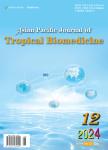Cladogynos orientalis Zipp. extracts inhibit cell culture-derived hepatitis C virus genotype 2a replication in Huh-7 cells through NS5B inhibition
Cladogynos orientalis Zipp. extracts inhibit cell culture-derived hepatitis C virus genotype 2a replication in Huh-7 cells through NS5B inhibition作者机构:Department of MicrobiologyFaculty of PharmacyMahidol UniversityBangkok 10400Thailand Department of BiochemistryFaculty of PharmacyMahidol UniversityBangkok 10400Thailand Department of PharmacognosyFaculty of PharmacyMahidol UniversityBangkok 10400Thailand
出 版 物:《Asian Pacific Journal of Tropical Biomedicine》 (亚太热带生物医学杂志(英文版))
年 卷 期:2019年第9卷第8期
页 面:346-352页
核心收录:
学科分类:1002[医学-临床医学] 100214[医学-肿瘤学] 10[医学]
基 金:supported by National Research Council of Thailand and Faculty of Pharmacy Mahidol University
主 题:Cladogynos orientalis Hepatitis C virus Cell culture-derived HCV genotype 2a
摘 要:Objective: To evaluate the potential anti-hepatitis C virus (HCV) activities of Cladogynos orientalis Zipp. ex Span and to investigate the molecular mode of action. Methods: Ethanolic and water extracts from various parts of Cladogynos orientalis were examined for cytotoxicity by MTT assay. Sub-cytotoxic concentrations of the extracts were used for further determining anti-HCV activity using cell culture-derived HCV genotype 2a propagated in HepaRG cell line. Immunofluorescence assay was performed to observe the effect on viruses at the pre-entry step. Mode of action at the post-entry step was investigated for the viral RNA and protein expressions by real time RT-PCR and Western blotting assays, respectively. Results: Although Cladogynos orientalis water extracts exhibited lower cytotoxicity than ethanolic extracts, all ethanolic extracts from roots, stems, and leaves of Cladogynos orientalis exhibited higher anti-HCV activities than water extracts. The highest anti-HCV activity was observed in infected cells treated with the extracts 5 h after absorption. No extracts showed pre-viral entry effect. At the post-viral entry step, only leaf ethanolic extracts inhibited NS5B expression, while all extracts did not inhibit HCV NS3 expression. Conclusions: Cladogynos orientalis ethanolic extracts could be further studied and the major active compound needs to be identified as a promising source for anti-HCV agents.



